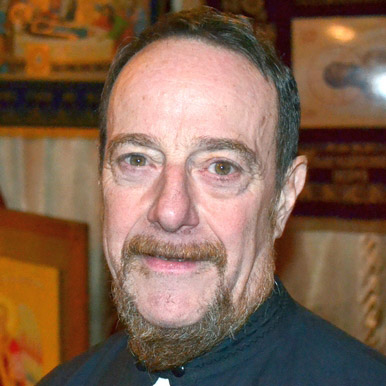The Fulfilment of the Promise
In the name of the Father and of the Son and of the Holy Spirit. God is one. Amen.
Today we celebrate the Presentation in the Temple of our Lord and Saviour Jesus Christ, 40 days after His birth. This celebration is based upon the purification of a new mother, 40 days after the birth of her son, as set out in the Old Testament book of Leviticus, chapter 12, verses 2 to 8. Our Gospel reading today from St Luke’s Gospel, chapter 2, verse 22 begins, and I quote: “And when the days for their purification according to the law of Moses were completed, they [that is, the Theotokos and St Joseph] brought [Jesus Christ] up to Jerusalem to present Him to the Lord,” concluded St Luke.
Now, in both the Old Testament and the New Testament this presentation in the Temple is for purification. However, there is an important difference between the ceremonies in the Old Testament and in the New Testament. St Luke states clearly that the new-born Jesus Christ is being presented to the Lord, God the Father. Thus, in a very deep and meaningful sense, the Son of God is being presented to His Father.
As St Luke tells us, the sacrifice that the Theotokos and St Joseph are offering on this important occasion in the Jewish Temple is two turtledoves and two pigeons—the minimum animal sacrifice that would be offered by those who are poor. St Bede offers us an important reflection on the Presentation in the Temple. He preached, and I quote: “[Holy] Mary, God’s blessed mother and a perpetual virgin, was, along with the offspring she had borne … free from all [submission] to the law. [Why? Because] the law says that a woman who ‘had received seed’ and given birth was to be judged unclean and that after a long period she, along with the offspring she had borne, were to be cleansed by victims [that is, animal sacrifices] offered to God. So it is evident that the law does not describe as unclean that woman who, without receiving man’s seed, gave birth as a virgin. Nor does it so describe the Son who was born to her. Nor does it teach that she had to be cleansed by [giving] sacrificial offerings. But as our Lord and Saviour, who in his divinity was the one who gave the law, when he appeared as a human being willed to be under the law…. So too his blessed mother, who by a singular privilege was above the law, nevertheless did not shun being subject to the principles of the law for the sake of showing us an example of humility,” concluded St Bede.
In other words, St Bede is preaching with great insight that neither Jesus Christ nor the Theotokos were “subject to the principles of the law” yet they chose “to be under the law.” Why then, let us ask, did the Theotokos and St Joseph bring Jesus Christ to the Temple for this Presentation? There were at least three reasons. First, it would have been very dangerous for the Theotokos and St Joseph NOT to observe the law—dangerous among the Jews, and even more dangerous with King Herod to imply in any way that Jesus Christ was King of the Jews. It was God’s plan that Jesus should be raised in obscurity—first in Egypt and then in Nazareth. Even later in His ministry, Jesus was careful to whom He revealed the future and to whom He spoke in parables.
Second, St Bede preached that the Presentation in the Temple took place “for the sake of showing us an example of humility.” Just as the Theotokos and St Joseph were humble despite the great gifts God had given them, so too can we be humble whatever gifts we receive from the Lord.
Third, as set out in today’s Gospel, the Presentation in the Temple offered an opportunity for the devout Simeon and the prophetess Anna to see Jesus Christ. “It had been revealed to [Simeon] by the Holy Spirit that he should not see death before he has seen the Lord’s Christ.” The Presentation offered the one opportunity for Simeon to see Christ before Jesus was taken by the Theotokos and St Joseph to Egypt and then to Nazareth. For Anna, who was 84 years old, the Presentation was a blessing extended by God for a life filled with personal prayer, communal worship and fasting.
St Bede preached of how, and I quote: “Simeon and Anna, a man and a woman of advanced age, greeted the Lord with the devoted services of their profession of faith. As they saw him, he was small in body, but they understood him to be great in divinity. Figuratively speaking,” preached St Bede, “this denotes the Jewish people, who, wearied by the long awaiting of his incarnation, were ready with both their arms (their pious actions) and their voices (their unfeigned faith) to exalt and magnify him as soon as he came [on earth].They were ready to acclaim him and say [in the words of Psalm 25/24, verse 5]: ‘Direct me in your truth and teach me for you are my saving God, and for you I have waited all the day.’ What needs to be mentioned, too, is that deservedly both sexes hurried to meet him, offering congratulations, since he appeared as the Redeemer of both,” concluded St Bede.
We too can rejoice today with the Theotokos and St Joseph and St Simeon and St Anna, because Jesus Christ can direct us in His Truth and teach us. Let us, women and men, girls and boys, welcome Christ as our Redeemer.
And so, we ascribe as is justly due all might, majesty, dominion, power and praise to God, Father, Son and Holy Spirit, always now and ever and unto the ages of ages. Father Emmanuel Kahn

 Archpriest Gregory Hallam
Archpriest Gregory Hallam
 Fr. Emmanuel Kahn
Fr. Emmanuel Kahn